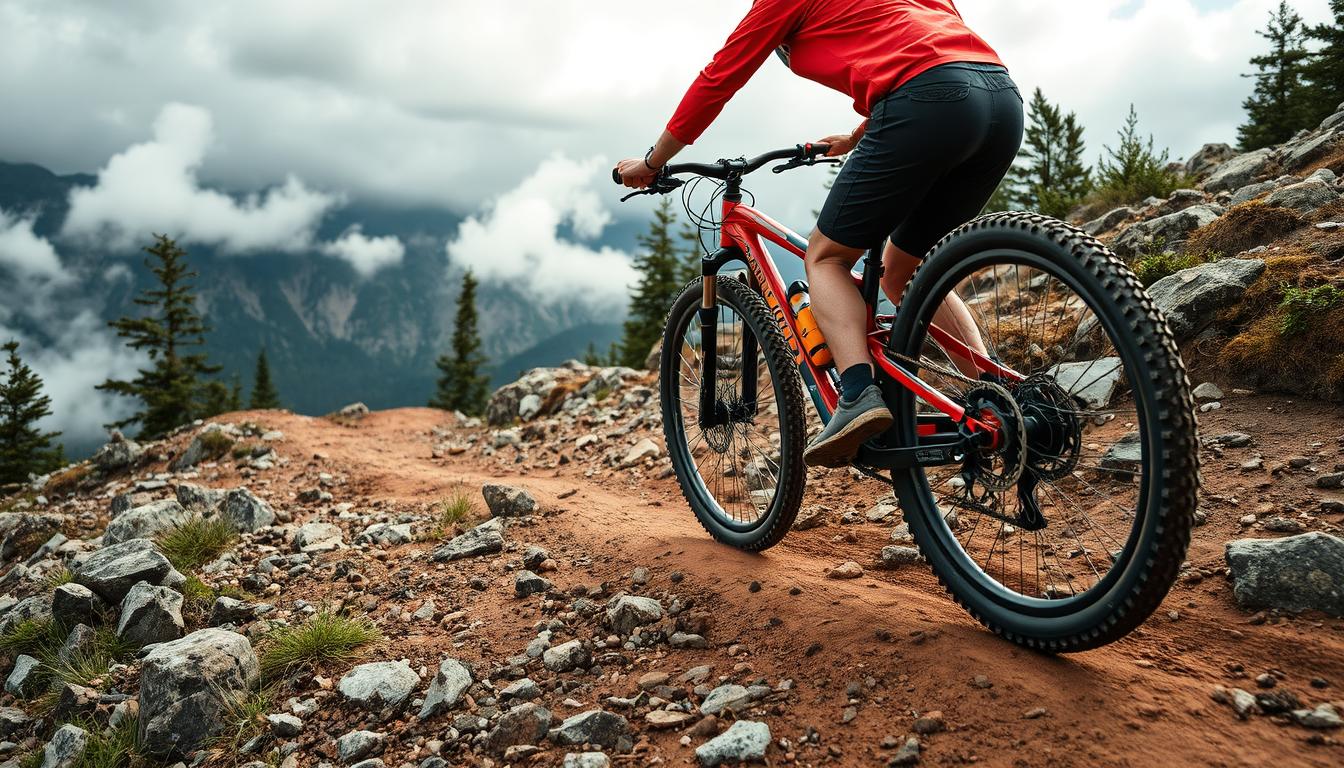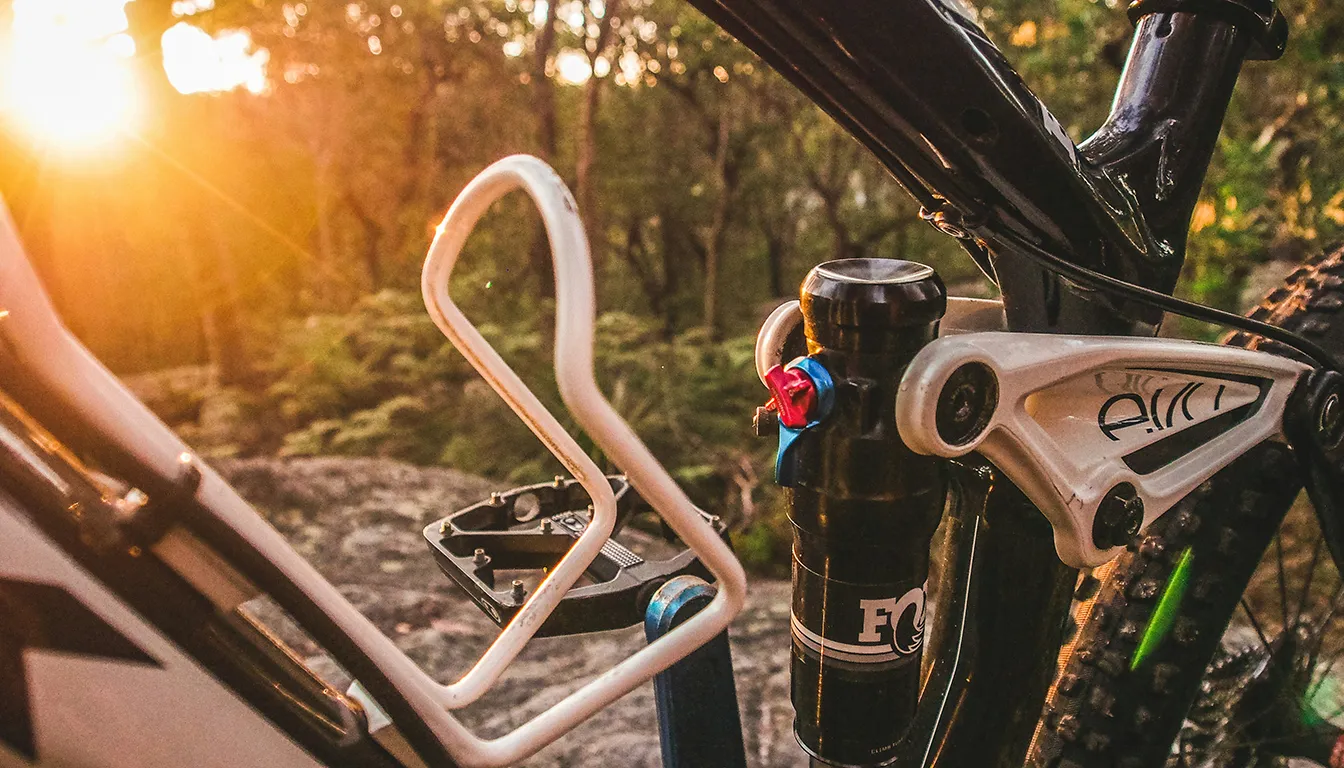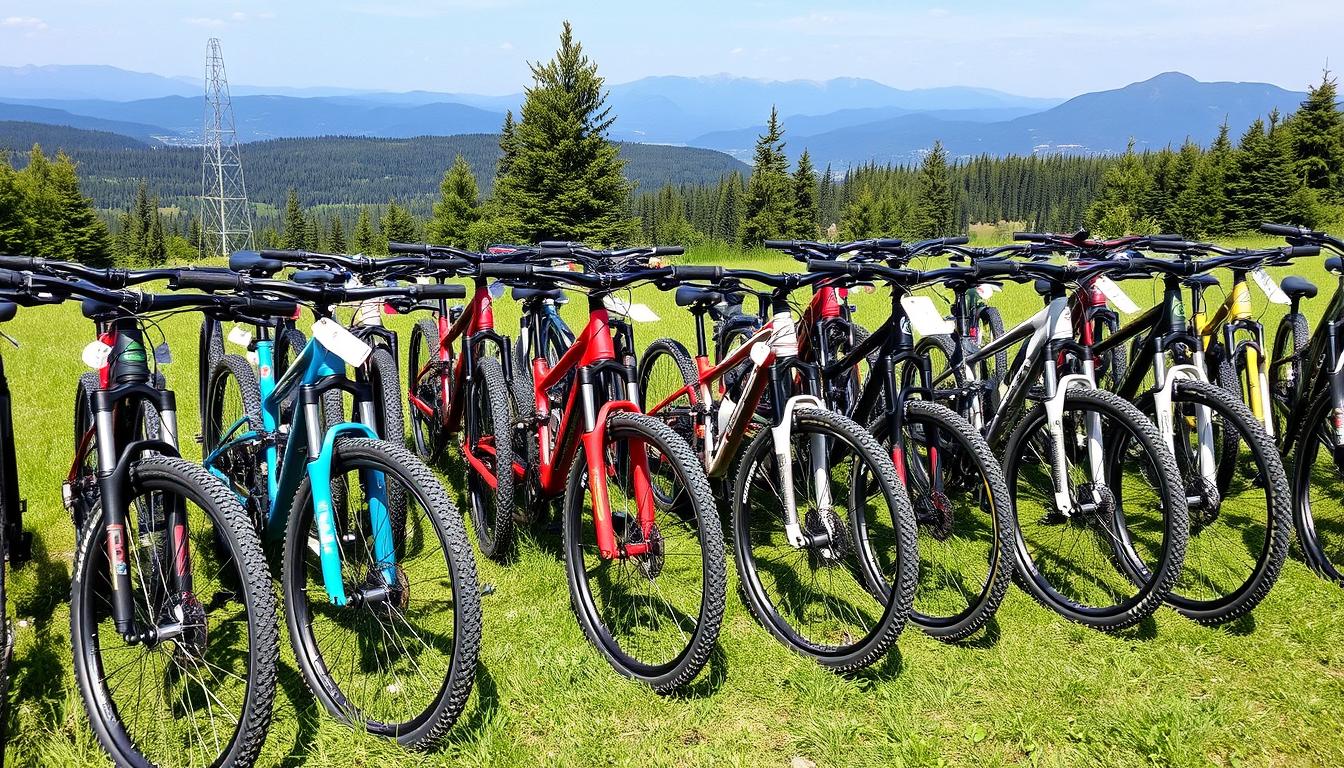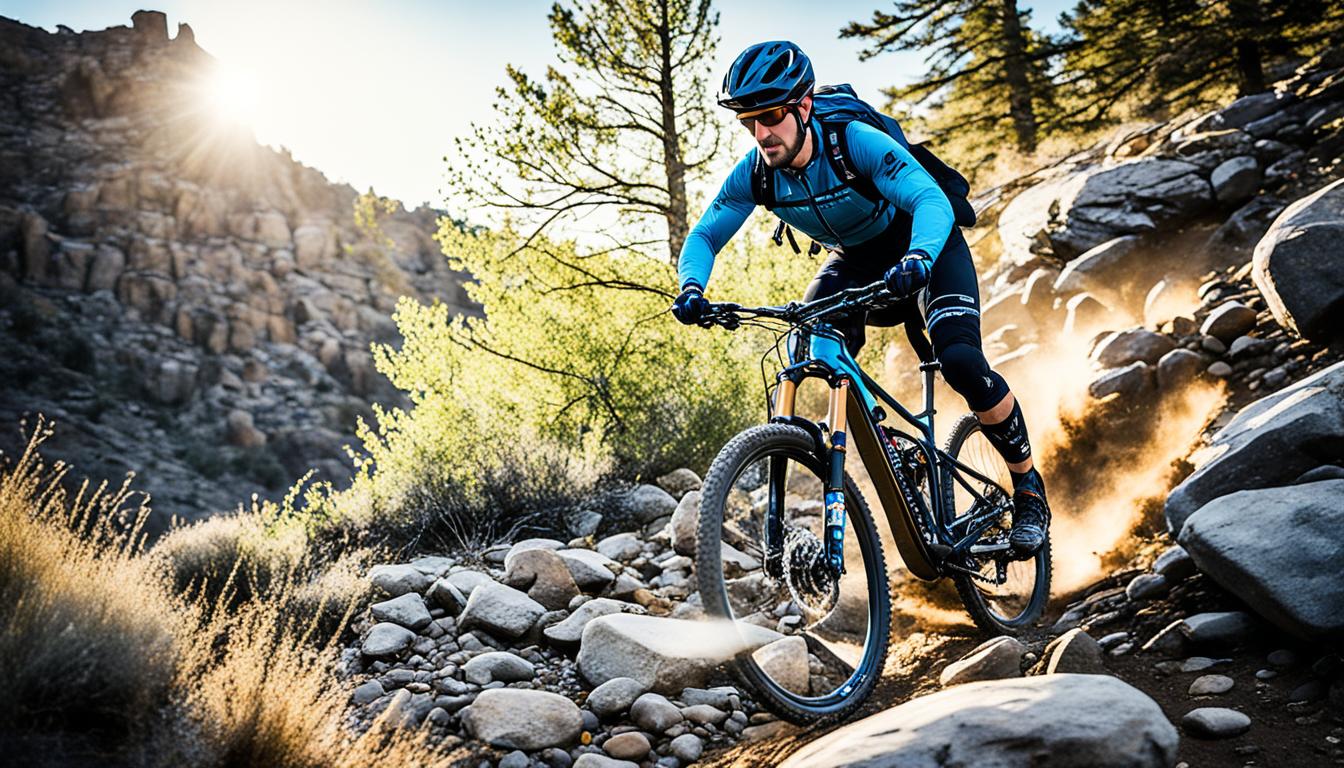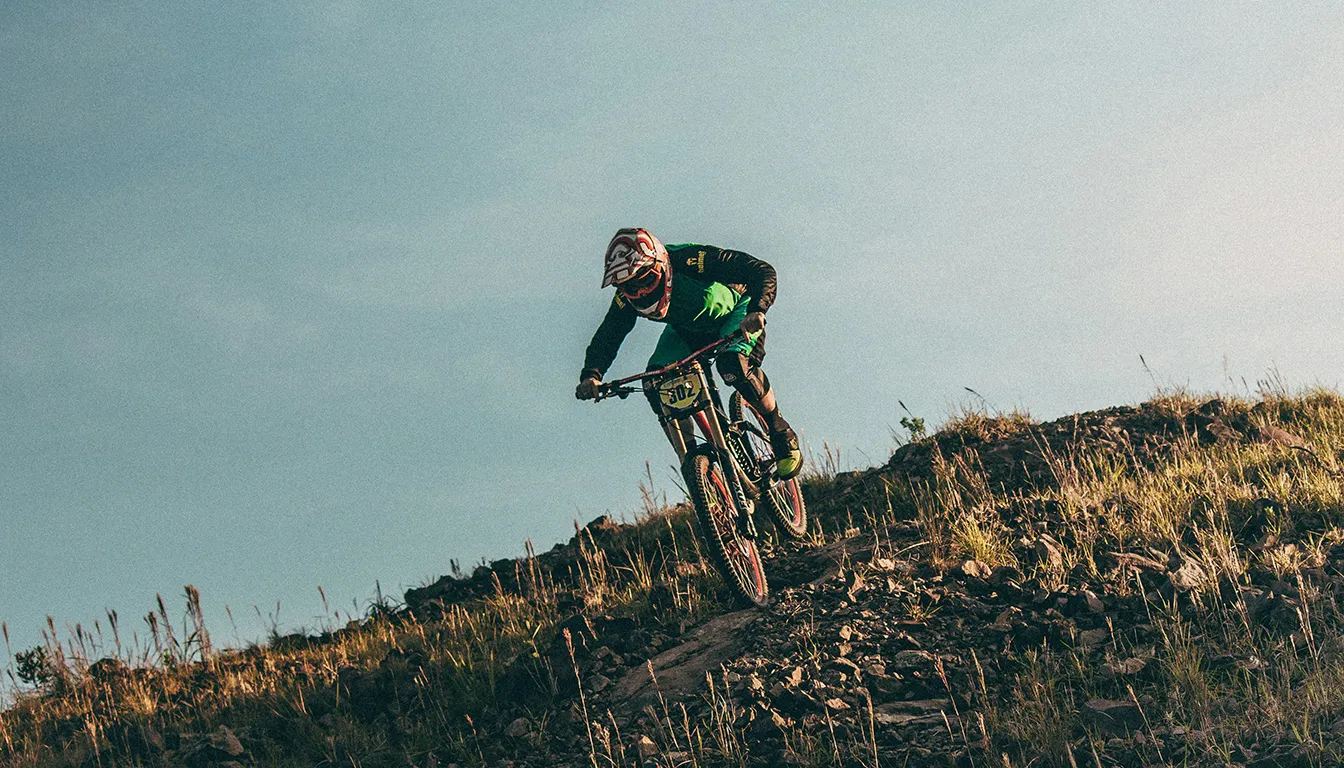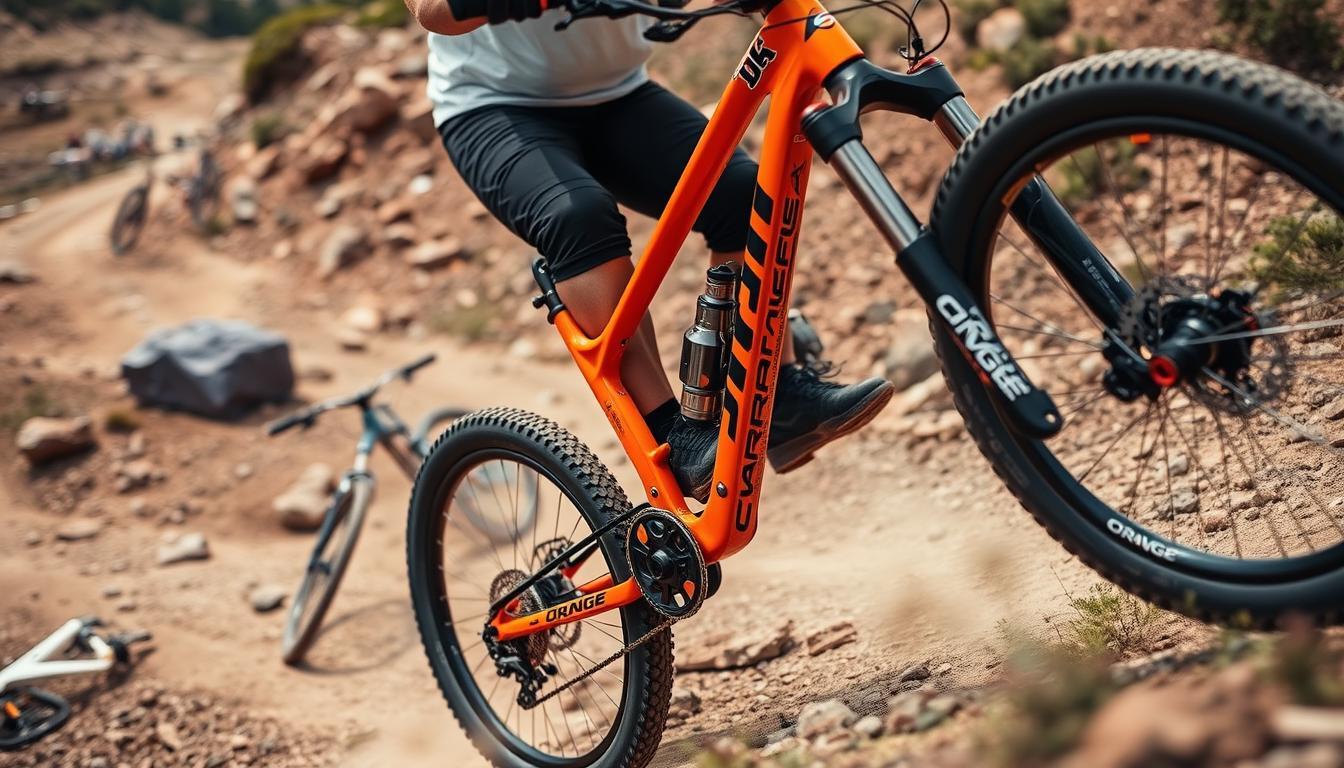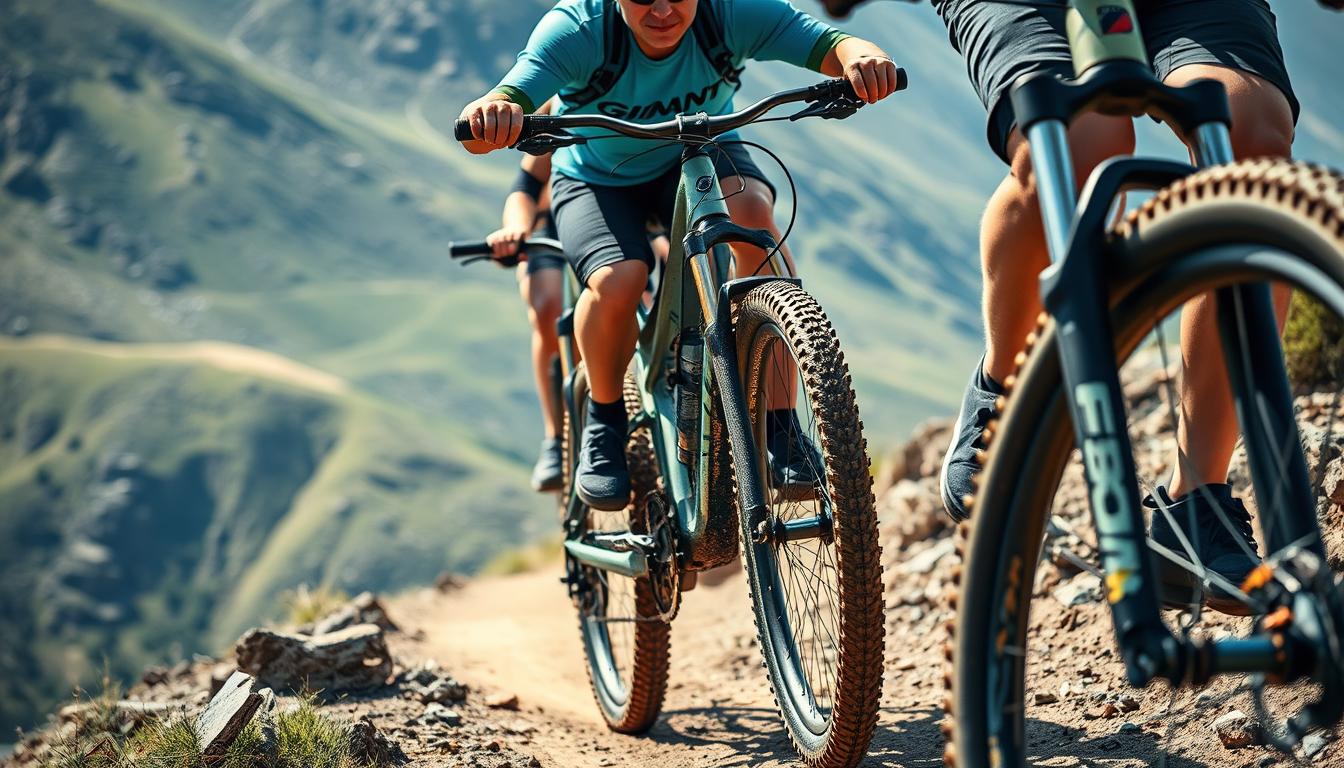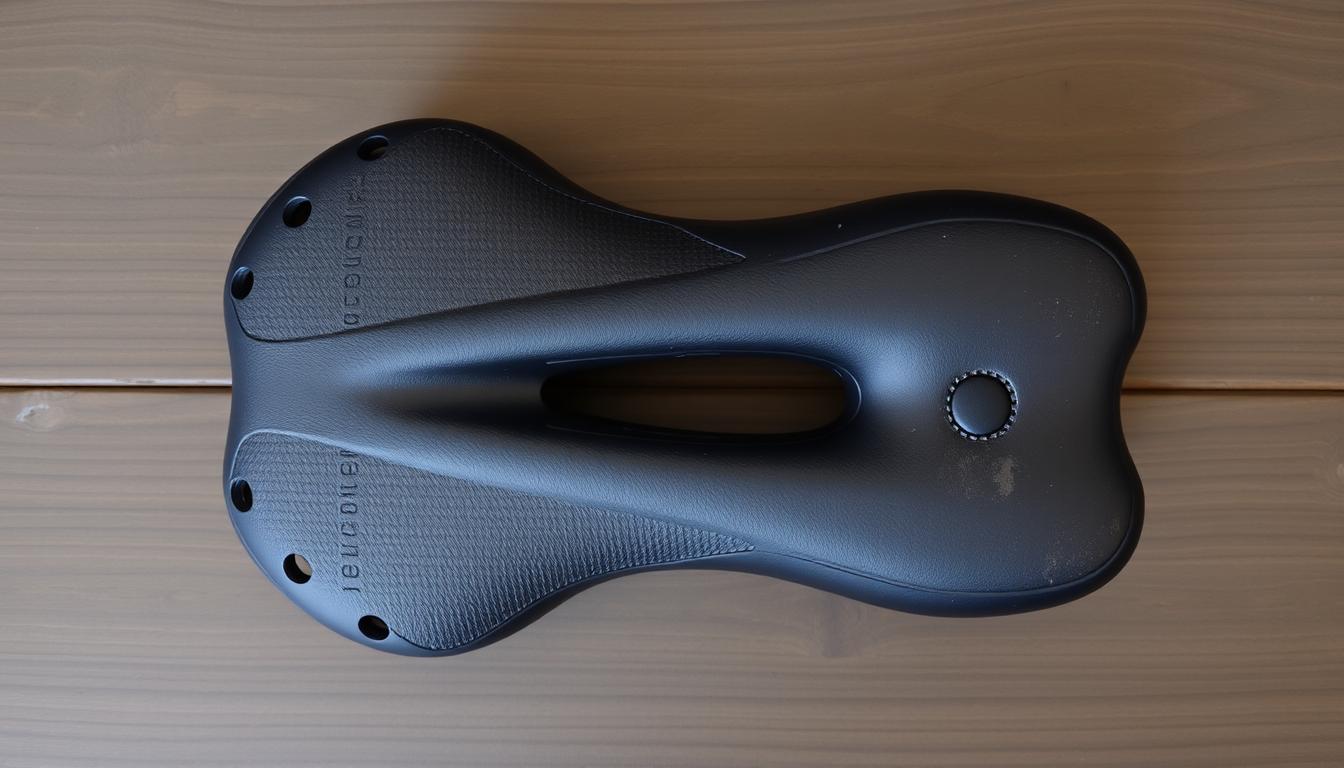A mountain bike with full suspension tackles tough terrains well. It has front and back systems to soak up shocks. This makes your ride smoother on rough trails. Full suspension is a big leap in mountain biking over 30 years.
Full suspension bikes boost comfort on bumpy paths. They help you corner and go down hills quickly. You’ll feel more confident and tackle obstacles better. Also, climbing becomes easier due to better grip. These bikes are perfect for avid mountain bikers wanting a better ride.
The Basics of Full Suspension Mountain Bikes
Full suspension mountain bikes bring together clever design and rider comfort. This enhances your ride on rough ground. Knowing about these bikes is key if you want to get better at mountain biking.
Definition and Features
Full suspension mountain bikes have a telescopic fork in front and a rear shock absorber. These features of full suspension improve grip, control, and comfort. They are perfect for tough trails where good ground contact matters. They make rides smoother and less tiring. Thanks to lighter designs in new models, these bikes are now as light as hardtails.
The Evolution of Mountain Bikes
The mountain bike evolution started with stiff, unsuspended frames. Early bikes were uncomfortable on rough terrain. Adding suspension made a big difference, making rides more comfortable on challenging paths. This improved performance. Today’s full suspension bikes are great for both climbing and downhill rides. They are becoming a favourite choice among cross-country racers, too.
For those who want to get better at uphill biking, many resources are available, like this guide to mastering uphill mountain biking. Picking the right bike is crucial for performing well on diverse terrains. Whether you choose a bike with short or long travel, the right full suspension mountain bike can make your rides fun and efficient on any trail.
Benefits of Riding a Mountain Bike Full Suspension
A full suspension mountain bike makes trail riding much better. It offers comfort, control, and confidence. This is great for beginners and experienced cyclists.
Enhanced Comfort on Rough Terrain
Full suspension bikes smooth out the bumps on rough trails. They soak up shocks, making rides less tiring. This means you can enjoy long rides on uneven paths with ease.
Improved Control and Stability
These bikes give you better control and stability. Their rear suspension keeps tyres in touch with the ground. This makes steering and cornering easier, leading to a better ride.
Greater Confidence for Riders
Full suspension bikes are perfect for those new to mountain biking. They help riders feel more confident on tough terrains. This makes learning and exploring new trails more fun.
How Full Suspension Affects Performance
Mountain biking on rough terrains shows how good full suspension bikes are. They improve handling and traction. This makes riding on challenging paths more fun and controlled.
Handling and Traction on Challenging Trails
Full suspension bikes keep stable on difficult grounds. They have a rear shock that absorbs hard impacts. This allows for better traction and smoother rides on trails.
Such a setup keeps tyres grounded, easing the way over roots and rocks. Riders feel more confident knowing their bike handles well on different terrains.
Downhill Performance Comparison with Hardtails
Full suspension bikes perform better on steep and rough downhills than hardtails. Hardtails do well on flat tracks but struggle on bumpy trails. Full suspension bikes give riders an advantage, helping them to go down quickly and safely.
They make tackling tough landscapes easier, improving downhill rides. For more on hardtail vs. full suspension bikes, see this article.
Terrain Suitability for Full Suspension Bikes
Choosing the right terrain is crucial for getting the most out of full suspension mountain bikes. These bikes do best on challenging paths. They offer benefits that improve your riding experience a lot.
Best Trails for Full Suspension Mountain Bikes
Full suspension bikes are perfect for technical trails with roots, rocks, and steep drops. They have 130 to 150 mm of travel. This provides comfort and stability for:
- All-Mountain riding
- XC Marathon races
- Trails with big elevation changes
When looking for the best trails, these models keep a good grip and comfort. This means a smoother ride over bumpy surfaces.
Comparing Terrain Performance with Hardtails
The terrain comparison between full suspension and hardtail bikes shows each type’s strengths. Hardtails are better on smooth grounds due to their lighter build. On tough trails, full suspension bikes do much better. The main differences are:
- Full suspension bikes have shock absorbers front and back. This makes for a comfier ride on rough paths.
- Hardtails, simpler in design, are better at pushing pedal power on flat grounds.
- Full suspension bikes smooth out bumps. This gives riders more confidence going downhill.
For those who value lightness and uphill speed, hardtails might be better. Yet, for tackling rough trails, full suspension bikes are the best pick. They make riding on tough trails much easier, enhancing the mountain biking experience.
Potential Downsides of Full Suspension Mountain Bikes
Full suspension mountain bikes have lots of benefits. yet, they also have downsides potential buyers need to think about. Their complex design means they’re more expensive and need more upkeep. They might not be as efficient on smoother trails, too.
Higher Cost and Maintenance Requirements
Full suspension bikes are usually pricier than hardtails. Take the Scott Spark RC Team Issue, which costs €6599. It’s much more than the Scott Scale RC Team Issue at €4799. This price jump is because of the extra parts and tech in full suspension bikes. To keep them running well, you need to look after both the front and back suspension often.
Impact on Weight and Efficiency on Smooth Trails
Full suspension bikes are heavier because of their complex parts. This extra weight can slow them down, especially on smooth trails like dirt roads. Here, lighter hardtails are better. While full suspension bikes are great for rough areas, they may not be as quick or efficient on easier paths. This could be an issue for riders who mostly stick to those areas.
Choosing the Right Mountain Bike for Your Needs
When picking a mountain bike, knowing how you ride is key. Full-suspension bikes are great for many styles, like cross-country, trail, enduro, and downhill. If you face tough paths often, a full-suspension bike gives you comfort and control. But for easier trails, a hardtail could be better for speed and performance.
Determining Your Riding Style
Your choice of bike depends a lot on how you like to ride. If you’re into technical paths, a full-suspension bike with its detailed design brings extra comfort. There are different models for different needs, such as:
- Cross-country: 100-120 mm travel
- Trail/All-mountain: 120-150 mm travel
- Enduro: 150-170 mm travel
- Downhill: 190-200 mm travel
Looking at various bike types helps you find one that suits your style.
Budget Considerations and Options
Mountain bike budgets can vary, with full-suspensions starting at about $899. These bikes, with their advanced tech, tend to cost more than hardtails. Though premium features add to comfort and control, it’s important to keep your budget in mind. There are bikes for every budget, from high-end carbon frames to more affordable alloy ones. By comparing costs and features, you can pick the best bike for you.
Conclusion
Full suspension mountain bikes bring many benefits, especially for those riding on tough terrains. They offer enhanced stability and grip. This means you have better control and balance, making your ride much more fun and comfy. With the shocks absorbed by the rear suspension, long rides become less tiring.
On the downside, full suspension bikes are more costly and harder to maintain than hardtails. If you’re watching your budget, a hardtail might seem a better choice, though it won’t give you all the performance perks of full suspension models. Your decision should consider your riding style, the terrains you prefer, and how much you want to spend.
Trying out both bike types is a smart move for anyone wanting to make the most of their mountain biking. Whether you go for a full suspension bike with all its advanced features or a hardtail that’s easier on the wallet, knowing what works for you leads to a rewarding experience.
FAQ
What is a full suspension mountain bike?
A full suspension mountain bike has both front and rear suspension systems. This setup boosts comfort, control, and grip on rough terrains. It’s great for riders on challenging trails.
How does full suspension improve the riding experience?
Full suspension offers superior shock absorption. It lessens impacts from uneven grounds. This means a smoother ride and less tiredness for the rider.
Are full suspension bikes better for technical trails compared to hardtails?
Yes, full suspension bikes are better for technical trails. They keep tires in touch with the ground. This provides more control and stability over rough spots like roots and rocks.
What are the main advantages of full suspension mountain bikes?
Key benefits include more comfort on bumpy lands, and better control and steadiness. They also boost rider confidence, especially in tricky areas.
Are full suspension mountain bikes more expensive than hardtails?
Yes, full suspension bikes usually cost more than hardtails. They’re more complex and have extra parts. They also need more upkeep, like regular servicing of both suspensions.
How can I decide between a full suspension and a hardtail mountain bike?
Your choice depends on how and where you ride. For rough trails, full suspension is better. For smoother paths, a hardtail might be more efficient.
What types of trails are ideal for full suspension mountain bikes?
Full suspension bikes are great for technical trails. They shine on steep drops and tough hurdles. They’re perfect for all-mountain rides or XC Marathon races.
Can full suspension bikes perform well on smooth terrains?
While they can manage smooth terrains, full suspension bikes may not be as quick as hardtails. Their weight and complexity can slow down acceleration and power.
